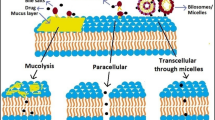Abstract
This study examined the solubility enhancement of 4 cox-2 inhibitors, celecoxib, rofecoxib, meloxicam, and nimesulide, using a series of pure solvents and solvent mixtures. Water, alcohols, glycols, glycerol, and polyethylene glycol 400 (PEG 400) were used as solvents and water-ethanol, glycerol-ethanol, and polyethylene glycol-ethanol were used as mixed-solvent systems. A pH-solubility profile of drugs was obtained in the pH range 7.0 to 10.9 using 0.05M glycine-sodium hydroxide buffer solutions. Lower alcohols, higher glycols, and PEG 400 were found to be good solvents for these drugs. The aqueous solubility of celecoxib, rofecoxib, and nimesulide could be enhanced significantly by using ethanol as the second solvent. Among the mixed-solvent systems, PEG 400-ethanol system had highest solubilization potential. In the case of meloxicam and nimesulide, solubility increased significantly with increase in pH value. Physico-chemical properties of the solvent such as polarity, intermolecular interactions, and the ability of the solvent to form a hydrogen bond with the drug molecules were found to be the major factors involved in the dissolution of drugs by pure solvents. The greater the difference in the polarity of the 2 solvents in a given mixed solvent, the greater was the solubilization power. However, in a given mixed-solvent system, the solubilization power could not be related to the polarity of the drugs. Significance of the solubility data in relation to the development of formulations has also been discussed in this study.
Similar content being viewed by others
References
Lane NE, Thompson JM. Management of osteoarthritis in the primary-care setting: an evidence-based approach to treatment. Am J Med. 1997;103(6A):25–35.
Needleman P, Isakson PC. The discovery and function of cox-2. J Rheumatol. 1997;24(suppl 49):6–8.
Bolten WW. Scientific rationale for specific inhibition of cox-2. J Rheumatol. 1998;25(suppl 51):2–7.
Depre M, Ehrich E, Van Hecken A, De Lepeleire I, Dallob A, Wong P, Porras A, Gertz BJ, De Schepper PJ. Pharmacokinetics, cox-2 specificity, and tolerability of supratherapeutic doses of rofecoxib in humans. Eur J Clin Pharmacol. 2000;56:167–174.
Hla T, Neilson K. Human cyclooxygenase-2 cDNA. Proc Natl Acad Sci U S A. 1992;89:7384–7388.
Silas S, Clegg DO. Selective cox-2 inhibition. Bull Rheum Dis. 1999,40(2):1–4.
Ran Y, Zhao L, Xu Q, Yalkowsky H. Solubilization of cyclosporin A. AAPS PharmSciTech. 2001;2(1) article 2.
Yalkowsky SH, Roseman TJ. Solubilization of drugs by cosolvents. In: Yalkowsky SH, ed. Techniques of Solubilization of Drugs. Vol 12. New York, NY: Marcel Dekker Inc; 1981:91–134.
Zhao L, Li P, Yalkowsky SH. Solubilization of fluasterone. J Pharm Sci. 1999;88:967–969.
Vavia PR, Adhage NA. Inclusion complexation of nimesulide with ∃-cyclodextrins. Drug Dev Ind Pharm. 1999;25:543–545.
Piel G, Pirotte B, Delneuville I, Neven P, Llabres G, Delarge J, Delattre L. Study of the influence of both cyclodextrins and L-lysine on the aqueous solubility of nimesulide; isolation and characterization of nimesulide-L-lysin-cyclodextrin complexes. J Pharm Sci. 1997;86:475–480.
Chowdary KPR, Hymavathi R. Enhancement of dissolution rate of meloxicam. Indian J Pharm Sci. 2001;63(2):150–154.
Baboota S, Agarwal SP. Inclusion complexes of meloxicam with ∃-cyclodextrin. Indian J Pharm Sci. 2002;64(4):408–411.
Wilkinson SG. Alcohols. In: Stoddart JF, ed. Comprehensive Organic Chemistry. Vol. 1. New York, NY: Pergamon Press, 1979;579–706.
Li P, Zhao L, Yalkowsky SH. Combined effect of cosolvent and cyclodextrin on solubilization of non-polar drugs. J Pharm Sci. 1999;88:1107–1111.
Yalkowski SH, Rubino JT. Solubilization of cosolvents 1: organic solutes in propylene glycol-water mixtures. J Pharm Sci. 1985;74:416–421.
Etman MA, Salama RO, Shamsedeen MA, El-Kamal A. Indian. J Pharm Sci. 2001;63(6):459–467.
Millard JW, Alvarez-Nunez FA, Yalkowsky SH. Int J Pharm. 2002;245:153–166.
Krishna G, Hodnick WF, Lang W, Lin X, Karra S, Mao J, Almassian B. Pharmaceutical development and manufacturing of a parenteral formulation of a novel antitumor agent, VNP 40101M. AAPS PharmSciTech 2001;2(3) article 14.
Powell M, Nguyen T, Baloian L. Compendium of excipients for parenteral formulations. PDA J Pharm Sci Technol. 1998;52:238–311.
Mottu F, Laurent A, Rufenacht D, Doelker E. Organic solvents for pharmaceutical parenterals and embolic liquids: a review of toxicity data. PDA J Pharm Sci Technol. 2000;54:456–469.
Author information
Authors and Affiliations
Corresponding author
Rights and permissions
About this article
Cite this article
Seedher, N., Bhatia, S. Solubility enhancement of cox-2 inhibitors using various solvent systems. AAPS PharmSciTech 4, 33 (2003). https://doi.org/10.1208/pt040333
Received:
Accepted:
DOI: https://doi.org/10.1208/pt040333




